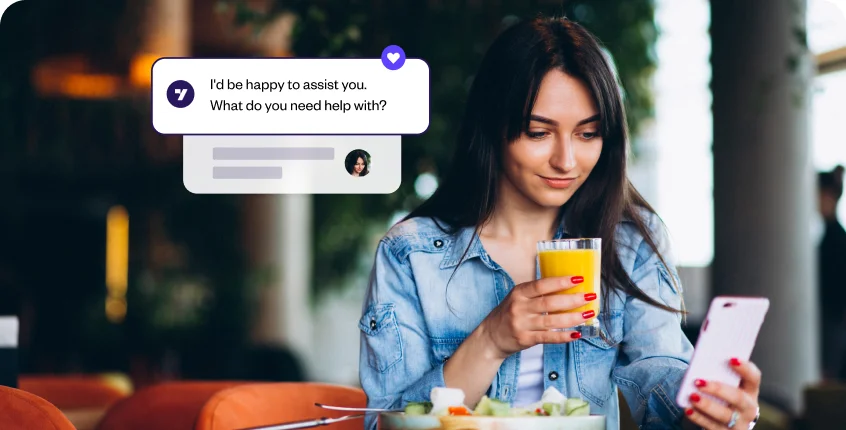This article decodes the role and capabilities of AI-powered customer service chatbots in the contemporary business ecosystem. As we proceed, you will gain insights into the fundamental differences between chatbots and human agents, discover the top 11 benefits these AI agents introduced recently, witness real-world chatbot applications, and even grasp the essentials of implementing one for their enterprise. As we step into 2024, understanding the strategic value and return on investment of these chatbots becomes vital for business leaders aiming for sustained growth and customer satisfaction.
Imagine logging onto a website with a pressing concern, greeted instantly by a friendly virtual assistant who addresses your problem and anticipates your next query. Or consider the relief of avoiding those dreaded “Your call is important to us” hold music, replaced instead by an efficient chatbot that has your billing issue sorted in a matter of seconds. This isn’t a glimpse into a distant future—it’s happening now.
With every passing second, as you read this, thousands of conversations are unfolding worldwide — and they’re not between humans. Surprised? An Accenture report says that 80% of customer service inquiries by 2025 will not be handled by humans, thanks to AI-powered chatbots. That’s not just a statistic; it’s a testament to the pervasive influence of AI chatbots in our daily lives.
As chatbots become the new norm, how do you ensure your business isn’t left behind?
Dive in with us as we unwrap the compelling journey of customer service chatbots, their unparalleled advantages, and how they’re setting the gold standard for customer interactions.
Related must-reads:
- 9 Best chatbot examples for businesses by industry [2024]
- Enterprise Chatbot – A Guide for Enterprises [2024]
What is a customer service chatbot?
Imagine a personal assistant who is always available, fluent in multiple languages, never taking a break, and consistently delivering top-notch service. It is not some overpaid executive assistant but a customer service chatbot. It’s not merely a script-driven pop-up on your website. These chatbots are intelligent, adaptive entities powered by AI, capable of pulling from vast knowledge repositories to answer your customers’ diverse queries.
Utilizing sources such as FAQs, knowledge bases, and past interaction data, AI chatbots excel in recognizing various forms of the same question, allowing them to deliver tailored responses instantly. These aren’t just canned responses. They’re real-time responses in a tone reflective of your brand’s personality, ensuring consistency across the board.
Some might argue, “How are these different from the chatbots we are using already?” Here’s a little secret: the next-gen AI-powered chatbots, like those offered by Yellow.ai, are not just reactive but are proactive. It is the power of advanced AI algorithms providing a transformative customer experience.
So, why might you consider having this modern marvel in your enterprise?
- Global reach: Cater to a diverse customer base, offering support in multiple languages.
- Omnipresence: Whether it’s your website, mobile app, or social media platforms, be present ubiquitously.
- 24/7 availability: While human agents need breaks, chatbots don’t. They’re there, round the clock, ensuring your customer’s queries never go unanswered.
- Economical: Reduce overheads associated with extensive customer service teams without compromising quality or efficiency.
Customer service chatbots are beyond just answering questions. They enhance the overall experience, increasing customer loyalty and improving brand perception.
AI chatbot vs. humans: Best pick for customer service
The debate is age-old: Man vs. Machine. But when it comes to customer service, is one genuinely superior to the other? At the heart of it, every business seeks to strike the right balance between efficiency and empathy. Let’s delve into a comparative analysis, exploring the unique strengths of both AI chatbots and human agents. And while the modern world sways towards AI-driven solutions, the quintessential human touch remains irreplaceable.
To visually aid this discussion, here’s a table that contrasts the strengths of AI chatbots and human agents in customer service:
| Features/strengths | AI Chatbots | Humans |
| Response time | Instant & consistent | Varies by individual & workload |
| Language abilities | Multilingual; can be trained in multiple languages | Depends on individual proficiency |
| Availability | 24/7 with no breaks | Limited hours; breaks required |
| Scalability | Handle multiple queries simultaneously | Limited by individual capacity |
| Cost efficiency | Reduces overhead costs; Self-trained, no human-driven training required | Training, recruitment, and salary costs |
| Personalization | Hyper-personalization at scale possible with human-like empathy | Empathetic, intuitive responses |
| Cultural sensitivity | Requires specific training | Natural understanding & adaptability |
| Learning | Continuous machine learning; iterative | Experience-based learning; is less consistent |
While the table summarizes the key points, let’s dissect the details:
Strengths of AI chatbots
- Unparalleled response time: With the on-demand nature of today’s consumers, chatbots shine with their capability to provide instantaneous responses, crucial especially for sectors like online retail.
- Global language support: From Arabic to Bahasa Indonesia, chatbots break language barriers, effectively serving a global customer base. For example, chatbots powered by Yellow.ai can serve 135+ languages and dialects over text and voice channels.
- Always on: Unlike human counterparts, chatbots don’t clock out. They’re ever-ready to assist, ensuring customers are never left waiting.
- Economic sense: With no sick leaves, training sessions, or even coffee breaks, chatbots offer an economical solution, cutting customer service costs by a significant margin.
- Adaptive learning: Leveraging AI, chatbots refine their responses based on interactions, leading to a more enriched customer experience over time.
Strengths of human agents
- Empathy & compassion: Authenticity is irreplaceable. The innate ability to sense a customer’s emotional state and respond with genuine care is exclusive to humans.
- Adaptability: Human agents can pivot seamlessly, be it a sudden change in conversation direction or an unexpected query.
- Cultural nuances: The innate ability to detect and respect cultural nuances makes human agents invaluable, especially when dealing with a diverse clientele.
- Experience-based judgments: Leveraging personal experiences, human agents can offer solutions sometimes beyond a chatbot’s programmed understanding.
Related read: What is Customer Service Automation
Top 10 benefits of chatbots for customer service in 2024
1. Rapid response times
In an era where speed is paramount, AI chatbots shine in offering instantaneous responses to customer inquiries. These automated responders immediately address customer questions and concerns, which is especially vital when an instant decision is needed, such as in the case of product choices or urgent troubleshooting.
AI Chatbots powered by Yellow.ai take this responsiveness a notch higher. These chatbots are agile in providing essential data promptly, contributing to a customer’s swift decision-making process.
2. Omnichannel support
The modern consumer has evolved, frequently switching between multiple platforms to communicate – be it phone, email, popular messaging apps, or social media. They desire a consistent conversational journey, allowing them to pick up where they left off, irrespective of the channel they’re on.
Yet, a significant number of enterprises fall short in delivering this seamless experience. By leveraging AI chatbots, businesses can bridge this gap. By integrating Yellow.ai chatbots across various channels, brands are ensuring consistent, timely responses. The chatbot remembers past interactions, ensuring customers don’t have to repeat themselves when they switch platforms.
3. Expanded self-service opportunities
The modern customer prioritizes autonomy and efficiency. Customer service agents notice a palpable sense of frustration among customers when they cannot execute simple tasks independently. Recognizing this need for autonomy, AI chatbots empower customers with tailored self-service solutions, allowing them to address primary concerns at their own pace and on their own terms.
Yellow.ai bots stand out in this realm. Beyond just redirecting users to general resources such as community forums or FAQ pages, they engage customers more interactively. Consider a scenario where a user seeks information on a product’s warranty. Instead of merely providing a link to the warranty page, a Yellow.ai bot could fetch key warranty details directly from the database, present a summarized version to the user, and even offer related topics that might interest the customer. With every interaction, these bots refine their self-service provisions, ensuring they meet evolving customer needs with increasing precision.
4. Lightened load for customer service agents
The daily grind of customer service agents is no walk in the park. They juggle multiple conversations, address various queries, and often find themselves handling the same fundamental questions repeatedly. Over time, this hampers their productivity and can lead to burnout.
AI chatbots, especially the advanced ones powered by platforms like Yellow.ai, have evolved tremendously over the years. No longer restricted to just addressing basic inquiries, these chatbots can now handle complex questions, process intricate requests, and even predict customer needs based on historical data. AI Chatbots significantly lighten the load for human agents by taking on numerous queries.
5. Boost in sales
In the evolving sales landscape, AI chatbots are becoming game changers. These 24/7 virtual assistants, fueled by machine learning, not only handle customer queries and offer tailored recommendations, paving the way for seamless purchases. They ensure potential leads are nurtured outside standard business hours, often increasing conversions.
Beyond just addressing immediate needs, AI chatbots can tap into vast amounts of data, analyzing customer behavior, preferences, and past interactions to offer highly personalized shopping experiences. By predicting what a customer might need or showcasing products that align with their interests, chatbots can subtly upsell or cross-sell, driving higher cart values. By understanding preferences and past interactions, they suggest complementary products or highlight promotions, effectively driving up cart values while reducing potential purchase barriers.
6. Enhanced customer satisfaction
Customer satisfaction is no longer just about resolving inquiries. It’s about creating an experience that is both seamless and memorable. By providing concise and accurate information, AI chatbots enhance customer journeys by answering their queries and suggesting related topics, promotions, or resources that can be valuable for them. It ensures that the customer gets answers and derives additional value from the interaction, enhancing their overall satisfaction and experience with the brand.
See how major brands like Indigo Airlines have boosted their CSAT to 87% with AI automation powered by Yellow.ai.
“At Indigo, we are highly focused on providing a fast, efficient and memorable experience for our customers. Yellow.ai has helped us accelerate our AI automation journey enabled by DynamicNLPTM where we can design conversational AI flows within minutes, while reducing training data-related costs and efforts. The Dottie bot seamlessly resolves queries for 500K+ users every quarter, providing customers with a quick and hassle-free experience for a plethora of services like web check-in, booking management, flight information and more, on their preferred digital channels.”
Abir Lavasa
Sr. Manager, Digital, Indigo

7. Continuous availability
Today’s global market demands a customer service solution transcending time zones and geographical barriers. AI chatbots ensure businesses are always “open” to assist, providing a perpetual presence that can significantly impact international customers or those browsing after traditional business hours. This 24/7 availability ensures that every customer from every part of the world always has access to support, thereby reducing potential frustration from unmet needs during off-hours.
8. Improved Net Promoter Scores (NPS)
Net Promoter Score, a widely recognized metric, gauges customer loyalty by asking one simple question: “How likely are you to recommend our company to a friend or colleague?” A positive NPS indicates happy, satisfied customers, which can lead to increased referrals and growth. AI-powered chatbots play a pivotal role in elevating this score.
By ensuring consistent, immediate, and accurate responses, chatbots foster positive customer experiences. With platforms like Yellow.ai enhancing bot-human collaboration, customer grievances are addressed more efficiently, often before they escalate. When businesses eliminate common pain points – such as waiting times, unanswered queries, or miscommunications – the likelihood of customers becoming promoters significantly rises, thereby elevating the NPS.
9. Valuable insights from conversation history
Having a record of customer interactions is more than just a log – it’s a treasure trove of insights. AI chatbots not only facilitate these interactions but also document them meticulously. When customers engage with chatbots, they are often more candid, asking questions they might hesitate to ask a human representative. This openness can reveal invaluable information about customer preferences, concerns, and decision-making processes.
With platforms like Yellow.ai, every chatbot interaction becomes a part of a broader narrative, painting a clearer picture of each customer’s journey. These recorded dialogues help customer service agents and sales teams personalize their approach, tailoring their strategies based on previous conversations. Furthermore, analyzing these conversations can identify gaps in the chatbot’s current knowledge, providing opportunities for refinement and betterment. The conversation history serves dual purposes: enhancing customer experience and refining the chatbot’s efficiency.
10. Cost-effectiveness
Businesses are perennially under pressure to optimize expenses without compromising quality. Here, chatbots emerge as a formidable ally. While it’s indisputable that an initial investment is involved in implementing AI chatbots, the subsequent savings and return on investment (ROI) are noteworthy. Instead of perceiving them merely as digital assistants, it’s pertinent to view chatbots as versatile entities that handle multiple facets of customer interaction, thereby reducing the need for a proportionate increase in customer service staff as the business scales.
Is your enterprise maximizing cost savings yet? Calculate the ROI with Yellow.ai powered chatbots.
Examples of awesome customer service chatbots
#1 Example – Travis: Tiket’s dynamic AI agent supercharging CX
Managing a plethora of queries efficiently is paramount in the hustle and bustle of the travel industry. Tiket.com faced the herculean task of efficiently addressing 40K+ travel queries daily. Aiming to elevate customer experience, they introduced “Travis,” a dynamic AI agent designed in collaboration with Yellow.ai.
This agent offers instant resolutions to most customer queries and facilitates easy access to the latest promotions and loyalty benefits. As a result, Tiket.com witnessed an impressive 2x improvement in customer satisfaction scores and resolved 80% of monthly queries without any agent assistance, handling a whopping 2.8M support messages in just a quarter.
#2 Example – Zenyum: Crafting a personalized omnichannel customer experience
Embarking on a journey to revolutionize customer interaction in the Southeast Asian Healthcare Tech space, Zenyum elevated its customer experience by integrating an omnichannel strategy, implemented through a bot developed in synergy with Yellow.ai.
This virtual assistant brought to life across various platforms such as Facebook Messenger and WhatsApp, not only supported the massive web traffic but also provided personalized assessments and solutions to users, exchanging over 900K messages across channels and handling 25K+ new sessions. Zenyum, with its ‘human-like’ virtual assistant, demonstrated a strategic and customer-centric approach to managing large-scale customer interactions.
#3 Example – Rafa: UnionBank’s beacon of digital transformation
Leading the future of banking requires vision, agility, and a willingness to adapt. UnionBank embraced this philosophy by launching “Rafa,” their dynamic AI agent, designed with Yellow.ai, to redefine their digital customer service approach.
With Rafa, UnionBank’s customers can swiftly get resolutions to a large majority of their queries on multiple channels. It has led to an impressive 3X increase in the bot’s monthly adoption rate and significantly reduced operational costs. By focusing on self-serve options and quick resolutions, UnionBank has set a gold standard in the banking sector for digital customer service.
How to make a chatbot for customer service?
Crafting a customer service chatbot involves strategic planning, a deep understanding of your audience, and implementing the right tools. Here’s a step-by-step guide to help you embark on this journey:
- Define the purpose: Understand the primary goal of your chatbot – whether it’s answering FAQs, guiding users through a purchase, or providing real-time support.
- Identify the platform: Decide where to deploy your chatbot – your website, social media platforms, or a standalone app.
- Draft a conversation flow: Create a logical and user-friendly conversation flow covering common queries and concerns.
- Integrate with existing systems: Ensure your chatbot can easily retrieve and use data from your existing CRM, inventory, or other systems.
- Test & iterate: Once built, test your chatbot rigorously. Gather feedback, make improvements, and ensure it delivers a seamless user experience.
- Deploy & monitor: Roll out your chatbot to your audience and continuously monitor its performance. Analyze chat logs to uncover new areas for improvement.
While these steps might sound daunting, there’s a tool that can make this process incredibly seamless – Yellow.ai’s No-Code Builder.
Yellow.ai’s No-Code Builder: Craft, deploy, & scale with ease
Accelerate your chatbot’s launch with Yellow.ai’s industry-leading Dynamic Automation Platform. Even with zero coding expertise, you can swiftly bring your intelligent AI chatbot to life, ensuring enriched customer engagements.
Zero setup call deflection: Use Yellow.ai DocCog’s cognitive knowledge search engine to extract essential data effortlessly and harness DynamicNLPTM and OpenAI API (GPT-3) models. Automate over 1000 routine queries and improve call deflection with DocCog’s strategic fallback methods.
Omnipresent deployment: With Yellow.ai’s No-Code Platform, enjoy the power of the Dynamic AI Agents. These agents have an intuitive drag-and-drop interface and more than 50 node types. You can deploy chat and voice bots across varied channels and languages, leveraging the 150+ pre-built templates, all without diving into the complexities of coding.
Halve your time to market: Yellow.ai’s Dynamic Conversation Designer, armed with Generative AI, allows you to design AI chat and voice bots effortlessly, ensuring swift deployment and maximized user engagement.
Tap into ready-to-use templates: With the Yellow.ai Marketplace, deploy Dynamic AI agents at twice the speed. Access over 150 industry-specific workflows and templates, continuously adding new components based on user preferences.
Your next step? Dive deep into the world of dynamic chatbot solutions with Yellow.ai. Get a firsthand experience of the platform’s prowess and envision how it can redefine customer interactions.
Navigating the chatbot revolution
High customer expectations accompany the fiercely competitive business world. Hence, businesses must have the appropriate tools and tech infrastructure to offer seamless and instant support. Customer service chatbots have just done that.
The adoption of chatbots has proven transformative, benefiting both established global brands and emerging startups. At the forefront of this revolution stands Yellow.ai, empowering businesses to effortlessly create, deploy, and optimize chatbots for maximum results. Yellow.ai’s no-code builder represents the future of customer service—accessible, efficient, and robust.
In essence, the future of customer service lies in automation, natural conversations, and AI-driven solutions. Don’t just observe the chatbot revolution; become an integral part of it!
Frequently asked questions (FAQs)
What is an example of a customer service chatbot?
A customer service chatbot is an AI-powered virtual assistant designed to interact with users, answer queries, and resolve issues in real-time. For instance, a dynamic AI agent, Indigo Airlines’ Dottie, enables round-the-clock self-serve options on WhatsApp and its website. Dottie helps automate 35+ use cases with 300+ user journeys like booking a meal, booking tickets, canceling flights, refunds, and managing loyalty programs by leveraging API integrations with Indigo’s backend systems.
How do I create a customer service bot?
Creating a customer service bot is streamlined with platforms like Yellow.ai’s Dynamic Automation Platform. This platform can help you effortlessly construct intelligent AI chatbots without any coding or extensive training. Our no-code builder offers drag-and-drop interfaces, pre-built templates, and deployment across multiple channels and languages, making the process both user-friendly and efficient.
Are chatbots the future of customer service?
Absolutely! Chatbots are rapidly becoming an integral part of the customer service landscape. Their ability to offer instant responses, 24/7 availability, and handle multiple queries simultaneously makes them indispensable for businesses aiming to meet modern customer expectations.
How do chatbots improve customer service?
Chatbots enhance customer service by offering immediate resolutions, reducing wait times, and being available around the clock. Additionally, today’s next-gen chatbots offer consistent and accurate assistance, minimize wait times, and can even provide personalized solutions based on user data. With their ability to integrate seamlessly across various digital platforms, these customer service chatbots ensure a unified and enhanced customer experience, driving CSAT and loyalty.
What is the role of chatbots in customer experience?
Chatbots play a pivotal role in shaping a positive customer experience. They provide instant support, offer personalized interactions, and ensure consistent service quality. Through seamless and efficient interactions, chatbots build trust and customer loyalty.
What are the advantages of a customer service chatbot?
The advantages of a customer service chatbot include round-the-clock availability, instant query resolution, reduced operational costs, higher customer satisfaction, the ability to handle multiple queries simultaneously, and a consistent level of service. Moreover, with platforms like Yellow.ai, businesses can swiftly implement and optimize chatbots, enhancing their benefits.






























